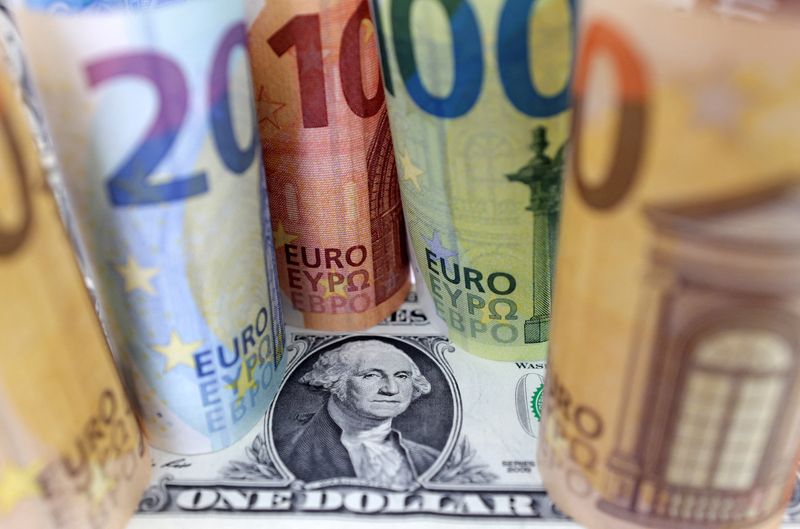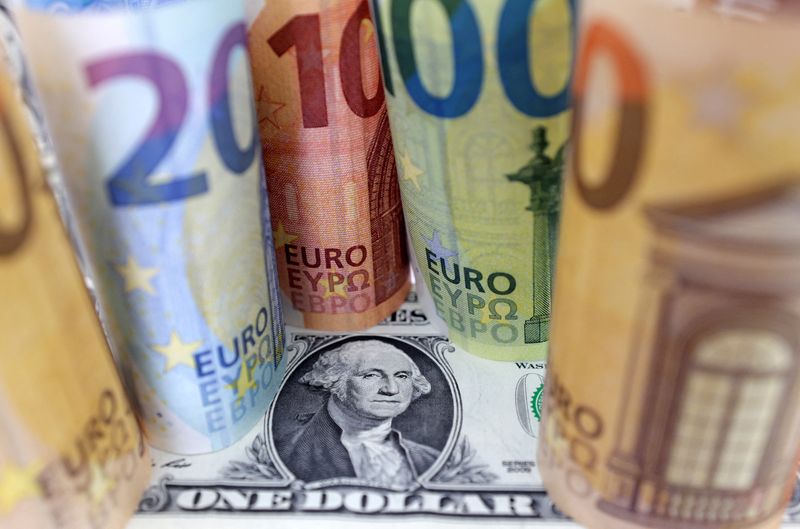Forex
Dollar eases as traders focus on upcoming central bank decisions


© Reuters. FILE PHOTO: U.S. Dollar and Euro banknotes are seen in this illustration taken July 17, 2022. REUTERS/Dado Ruvic/Illustration/File Photo
By Saqib Iqbal Ahmed
NEW YORK (Reuters) – The U.S. dollar eased against a basket of currencies on Tuesday as traders awaited a raft of central bank interest rate decisions this week, including one by the Federal Reserve on Wednesday.
The , which measures the currency against six major counterparts, was down 0.07% at 105.01, not far from the six-month high of 105.43 touched on Thursday. The index rose for its ninth straight week last week, its longest winning streak in nearly a decade.
Resilient U.S. growth has fueled a rebound in the dollar in recent weeks though the rally will likely be tested by a gauntlet of data and Wednesday’s Fed interest rate decision.
The dollar came under some pressure against the euro on Tuesday following a report that indicated the European Central Bank may soon start discussing how to drain some of the excess liquidity in the banking system, while the yen wallowed near 10-month lows against the dollar.
A Reuters report on Monday citing six sources said the debate over the multi-trillion-euro pool of excess liquidity sloshing around banks was likely to start next month.
The excess cash dulls the impact of the ECB’s rate hikes by reducing competition for deposits and results in hefty interest payments – and ensuing losses – by some central banks.
The euro was about flat at $1.06915, after rising as high as $1.0718 earlier in the session.
Some analysts, however, see further gains for the U.S. currency.
“If we look at the price action, it has generally been peripheral stories that have weighed on the dollar, like the minimum reserves leak out of the ECB yesterday,” said Simon Harvey, head of FX analysis at Monex Europe.
“This will do little to weigh on the dollar when the more dominant narratives of U.S. exceptionalism and a more credible higher for longer message from the Fed come back into play,” Harvey said.
Traders expect the Fed to keep rates on hold at its upcoming meeting, according to the CME FedWatch tool, though focus will be on the central bank’s forward guidance.
The Australian dollar was 0.43% higher after minutes of the Reserve Bank of Australia’s latest policy meeting signaled that there would be more interest rate hikes to come.
The Canadian dollar was trading 0.62% higher after having strengthened to a six-week high against its U.S. counterpart on Tuesday, as investors raised bets on additional interest rate hikes by the Bank of Canada following hotter-than-expected inflation data.
The yen was last down 0.07% versus the greenback at 147.70 per dollar, drawing a lot of focus at the moment, as the BOJ prepares to meet to discuss monetary policy on Friday.
The last time the yen was this weak was last autumn, when Japanese authorities intervened to prop it up.
Expectations are for the BOJ to maintain its policy of ultra-low interest rates and reassure markets that monetary stimulus will stay in place, at least for now, even as Governor Kazuo Ueda stoked speculation of an imminent move away from the central bank’s current policy stance.
Meanwhile, the British pound was 0.12% higher at $1.2399, hovering near three-month lows, ahead of a Bank of England interest rate decision on Thursday which is expected to yield a final rate rise in the current cycle.
In cryptocurrencies, bitcoin rose 0.68% to $26,951, close to a 3-week high.

 Forex3 years ago
Forex3 years agoForex Today: the dollar is gaining strength amid gloomy sentiment at the start of the Fed’s week

 Forex3 years ago
Forex3 years agoUnbiased review of Pocket Option broker

 Forex3 years ago
Forex3 years agoDollar to pound sterling exchange rate today: Pound plummeted to its lowest since 1985

 Forex3 years ago
Forex3 years agoHow is the Australian dollar doing today?

 Cryptocurrency3 years ago
Cryptocurrency3 years agoWhat happened in the crypto market – current events today

 World3 years ago
World3 years agoWhy are modern video games an art form?

 Commodities3 years ago
Commodities3 years agoCopper continues to fall in price on expectations of lower demand in China

 Economy3 years ago
Economy3 years agoCrude oil tankers double in price due to EU anti-Russian sanctions





















